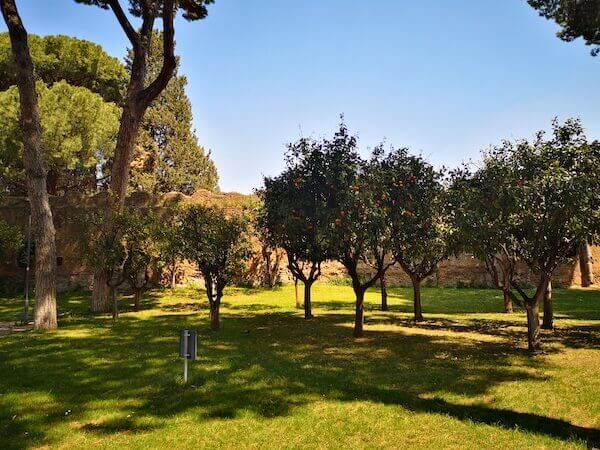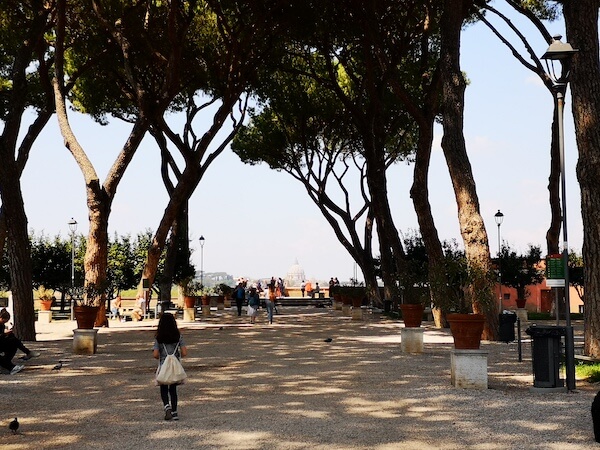How Many Orange Trees Are In Orange Garden In Rome, Italy
All you need to know about the orange garden of Rome (Giardino degli aranci): what makes it unique, how to visit what makes Rome's garden of oranges a favorite with locals and visitors alike.
The Orange Garden of Rome, or il Giardino degli Aranci, in Italian, is one of the most beautiful parks in Rome.
Perched on top of the Aventine Hill (Colle Aventino), it is a beautiful public garden with pretty orange trees and a stunning view over Rome and St Peter's dome, framed by the branches of beautiful pine trees.
It is a delightful green space and one of the most romantic spots in the city: if you are looking for places to propose in Rome, this should be high on your list!
If you come at sunset, you will see the sky turn that burning tone of orange that characterizes sunsets in Rome and the city at your feet.
It is an unforgettable sight!
I highly recommend you visit the garden of oranges when in the city.
It is close enough to be easy to reach from Rome's must-see sites but different enough that it will make you feel you stumbled up a hidden gem!
In this article, you will find all you need to know to add it to your Rome itinerary!
Rome was a poem pressed into service as a city. Anatole Broyard
Find more quotes inspired by Rome here

Please note: this post contains affiliate links and, should you make a purchase through them, we might make a small commission at no extra cost to you.
Rome's Orange Garden: where it is and how to get there
The garden of oranges sits at the top of the Aventine Hill, one of the historical seven hills of Rome.
Its complete address is Piazza Pietro D'Illiria, 00153 Roma RM, Italy and you will find it indicated on the maps of Rome as 'Parco Savello,' its official name.
The closest metro station is Circo Massimo (Linea Metro B), at the bottom of the hill, and you can walk up there in about 5 minutes.
The closes bus lines are 23, 30, 44 81, 130, 160,,280, ,170, 628, 716, 781 as well as tram n3.
The climb from the bottom of the hill to the park is steep but short and worth it.
As you go up, you cross Rome's rose garden, which is lovely and, on the way back down, you will have in front of you one of the most scenic monuments in Rome: the palace of the emperors on the Palatine Hill, right in front of you!
The climb up is along a paved road and while you will feel it in your legs, it poses little to no mobility issue and it is doable with a baby stroller too.
Orange garden Rome opening hours
The Garden of oranges has different opening times depending on the season
October to February 7.00am – 18.00 (6.00pm)
March and September: 7.00am – 20.00 (8.00pm)
From April to August: 7.00am – 21.00 (9.00pm)
If you can, I recommend you visit at sunset: this is one of the best sunset spots in Rome!
A quick history of the Garden of Oranges in Rome
The garden of oranges or Parco Savello as it is officially called was built in 1932 by architect Raffaele de Vico.
At the time, the garden belonged to the Dominican Order of the church of Santa Sabina, beside the park, but plans were drawn to turn the friars' garden into a beautiful terrace.
The idea was to get a viewpoint in Rome that could match the beauty and grandeur of Pincio and Gianicolo, two very famous terraces in Rome and the garden, at the top of a hill, was a perfect choice.
The idea of adding the orange trees came as a homage to the Dominicans and the peculiar role that the orange tree has in the history of their order.
They say that St Dominic loved to sit and preach under the shade of an orange tree and he is also said to have brought to Rome the orange tree that is still visible in Santa Sabina!
Garden of Oranges or Parco Savello: what's in a name?
The official name of the Orange Garden of Rome is Parco Savello. However, the orange trees are so characteristic of this park that Romans know it as 'il Giardino Degli Aranci' (Lit. the garden of oranges', 'the orange tree garden') and many of us would simply not recognize the name Parco Savello at all!
The name Savello however, has reason to exist. It came from that of the Savelli Family who, between 1285 and 1287, built in this location a fortification that still is partially visible on the right-hand side of the park.
What to see in the garden of oranges
The garden of oranges is first and foremost a viewing terrace, but there are few things to see besides the obvious and stunning Rome landscapes.
The fountain of the mask
The entrance to Parco Savello' is decorated by a peculiar fountain in the shape of a grumpy face spitting water into a large stone tub.

The fountain is not unique in Rome (via Giulia has another example) however, it has an interesting story.
The fountain's original design dates back to the XVI century when sculptor Bartolomeo Bassi created it on the basis of drawings by Giacomo della Porta.
Once finished, the mask was positioned on top of a thermal bath already in use in the Roman Forum as a watering hole and worked as a fountain for cattle for a long time.
Since then, the fountain got moved several times and even went through a period of disgrace, during which its parts got dismantled and separated.
In 1936, architect Munoz decided to revive it: it joined the two parts again and placed the fountain in its permanent home, where we can now admire it!
Did you know? Many fountains in Rome deliver delicious drinking water. You can read more about drinking water in Rome from the tap and fountains here.
The orange trees
The orange trees that give the name to this garden are on the lawns at the two sides of the main path leading from the front gate to the terrace.

They are very pretty and make up an elegant and relaxing space.
The park hasn't got a playground or any sort of facilities (no cafes etc) and this helps make this space a nice one for reading or relaxing rather than play or run.
The only problem here is the crowds: this is a pretty popular place!
The terrace
The start of the show in Parco Savello is the terrace and the view it offers over the city.

The terrace opens up, offering 180 degrees views over the roman skyline, especially over St Peter's dome.
Capturing the dome from here in a photo is hard for the amateur photographer as the light, especially in the evening, is against you, but the place is out of this work beautiful and should not be missed.

Visiting the orange garden with kids
I love visiting the garden of oranges with the kids as they are old enough to enjoy the view; however, it is not a place particularly geared towards children.

The park is flat and lovely for a small child to run around, but there are no climbing frames, and the terrace is, inevitably, a place that requires strict parental supervision.
While it may not be the best park for an afternoon of outdoor games, the garden of oranges is a good place for kids to let loose for a little while and it is also close to the secret Rome keyhole, always a hit with kids!
What to see near the Garden of Oranges Rome
Santa Sabina – just in front of the entrance to the garden of oranges sits the church of Santa Sabina.
This is one of the most beautiful churches in Rome and one that should not be missed.
Come before evening as the opening hours of the church are shorter than those of the park
The Rome keyhole – More often than not, when you hear a mention of the garden of oranges you also hear a mention of the Aventine hill keyhole, the' secret' keyhole view of the Vatican that you can get from the Aventine Hill.
Indeed the Rome keyhole and garden of oranges are close to each other but not exactly in the same spot!
The location of the Rome keyhole is just a few hundred meters up the road from Parco Savello: leave the park, pass Santa Sabina and you will quickly find it on your right! Read how to find the Aventine Keyhole here.
Rome's Pyramid – At the bottom of the Aventine hill you find one of the most peculiar monuments in Rome: Rome's pyramid.
The pyramid dates back to the I century AD and it is occasionally open to the public. Even when it isn't, however, it is worth seeing as it is truly peculiar!
Rome's protestant cemetery – Just beside Rome's pyramid lies the small protestant cemetery of Rome, a small, leafy romantic corner famous for being the resting place, among others of Keats and Shelley.
This is a beautiful, tranquil corner of the city worth visiting for its pretty appearance, the greats who rest here and, fun fact, a place where to experience one of Rome's best cat colonies!
How to include the Orange Garden in your Rome itinerary
Including the garden of oranges into your Rome itinerary is easy.
There are several options:
– You can visit after a day spent at the Colosseum, Roman Forum and Palatine Hill, which is just in front
– You can come here at sunset on the way to dinner in Testaccio
– You can visit on the same day as the protestant cemetery, Rome's pyramid and Ostia antica since the train to/from Ostia stops at the bottom of the Aventine hill
– You can visit after an afternoon at Caracalla's Bath, a short walk from the garden
The best hotels near Giardino degli Aranci
Giardino degli Aranci is located in a lovely, leafy area of Rome.
If you are looking for a quiet and secluded scenic neighborhood to call home for a while, you may choose between the following hotels:
Hotel Sant'Anselmo – with gorgeous, elaborately decorated rooms and wonderful staff
Hotel Villa San Pio – also on the tops of the Aventine, made up of 3 separate villas and with a beautiful garden
Fauno Urban Resort – a nice choice if you are looking for a secluded, modern resort in Rome with a nice garden and seasonal outdoor swimming pool
I hope you enjoyed this guide to the Garden of Oranges in Rome and it inspired you to go see it! Safe travel planning!
marta
My name is Marta, I am a travel-loving mama born and bred in that messy, wonderful, infuriating, awe-inspiring unbelievably beautiful city that is Rome. A classics graduate and professional travel blogger, on this site I share my insider tips to help you plan your dream trip to Rome, Italy.
How Many Orange Trees Are In Orange Garden In Rome, Italy
Source: https://mamalovesrome.com/orange-garden-rome/
Posted by: morristhoures.blogspot.com

0 Response to "How Many Orange Trees Are In Orange Garden In Rome, Italy"
Post a Comment